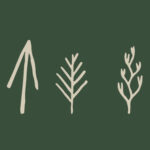Take a closer look at the forest floor
When you look closely, it’s amazing what you’ll find in the forest. Doug Gilbert, Dundreggan Operations Manager, explores the forest floor in search of wood ants. A keystone species in the forest – wood ants play a major role in nature throughout the world, and Scotland is no exception.
It was a long cold winter at Dundreggan, with temperatures rarely above freezing – and lots of snow. Ploughing through knee deep drifts during January, it is hard to imagine that anything as small as ants can survive here, but survive they do! We had a couple of bright sunny days in early spring and during the middle of the day the temperature rose into the low teens. With colleagues, Fiona and James, our new Caledonian Pinewood Recovery team, we took the opportunity to look for life in the woodlands at Dundreggan and found several wood ant nests in a flurry of activity. These fascinating insects deserve our attention at this time of year when many other invertebrates are yet to get going.
Carefully picking one or two up specimens, we were able to identify them as hairy wood ants, the most common ants of Dundreggan’s ancient woodlands. But what were they doing? Seemingly aimless, all the workers were trotting around the sunny side of the nest. There was no sign of ant trails extending away from the nest so they didn’t seem to be on the move for food. They were clustering, soaking up the sun, in order to transfer the heat from their bodies into the nest to warm it up more quickly. Effectively, they are their own central heating system. This is something that I had heard described recently at a training event held on wood ants by Buglife Scotland.
It is estimated that if you weighed all the animals living in the forest, including insects, invertebrates, birds and mammals, ants would make up 15-20% of the total animal biomass – in some tropical forests it can be as much as 25%. They are voracious predators of other invertebrates, cleaning the forest floor and the tree canopies of caterpillars, spiders and all sorts of other bug life. They assist some plants to spread – small cow-wheat flowers produce seeds coated with a sugary treat which the ants harvest – discarding the seed and helping to disperse the plant. They are food for some who can brave the strong biting jaws of the workers and their formic acid defence system. Badgers are especially brave when it comes to raiding ants nests looking for grubs, eggs and adult ants to eat. They also famously have a special relationship with aphids – farming them like livestock in order to get the “honeydew” excretions of these tiny plant juice suckers.
As Fiona, James and I walked the woodland, we came across several more wood ant nests and all of them were alive with activity. Enthused by the Buglife Scotland training event, and becoming more confident at identifying ants, I feel a survey of ant nests coming on this year. How many are there? Where are they and where are they not? Should we help them move into suitable new forest habitat as it becomes available? Are there any ‘guest ants’ at Dundreggan – ants of other species that inhabit wood ant nests?
If you’d like to find out more about ants, view our species profile here, or try Buglife Scotland’s page here.
Watch Doug explore a hairy wood ant nest at our Dundreggan Conservation Estate located just off Loch Ness in Glenmoriston, Scotland.

